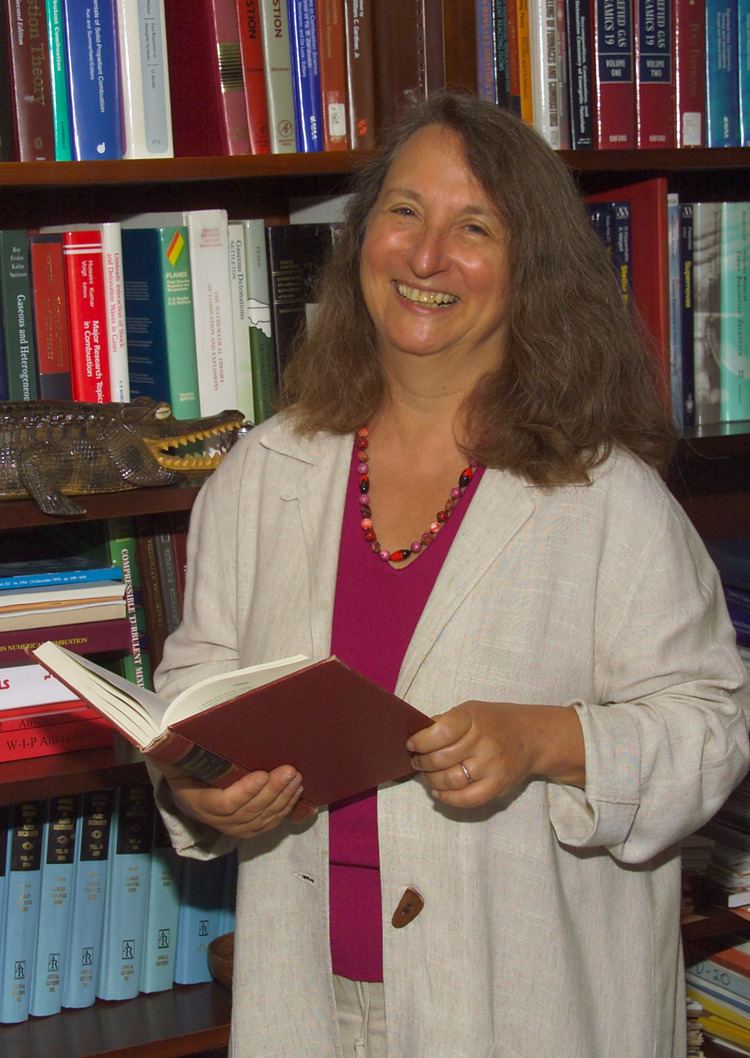Nationality United States Fields Astrophysics | Name Elaine Oran Spouse Daniel Oran | |
 | ||
Institutions University of Maryland, U.S. Naval Research Laboratory Notable awards Fluid Dynamics Prize (APS), 2013 Books Numerical Simulation of Reactive Flow Alma mater | ||
Residence United States of America | ||
Dr. Elaine Surick Oran is an American physical scientist and is considered a world authority on numerical methods for large-scale simulation of physical systems. She has pioneered computational technology for the solution of complex reactive flow problems, unifying concepts from science, mathematics, engineering and computer science in a new methodology. An incredibly diverse range of phenomena can be modeled and better understood using Dr. Oran's techniques for numerical simulation of fluid flows, ranging from the tightly-grouped movements of fish in Earth's oceans to the explosions of far-flung supernovae in space. Her work has contributed significantly to the advancement of the engineering profession.
Contents
- Education
- US Naval Research Lab
- Aerospace Engineering
- Publications
- Awards and honors
- Awards
- Honorary degrees
- Memberships
- References

Education
Elaine Surick is the daughter of Herman E. Surick and step-daughter of Doris Luterman-Surick. She is married to Daniel Oran.
Elaine Surick attended school in Philadelphia, Pennsylvania. Bryn Mawr College awarded her a bachelor's degree in both Physics and Chemistry (1966). She then attended Yale University, where she received a Masters from the Department of Physics (1968) and a Ph.D. from the Department of Engineering and Applied Sciences (1972).
U.S. Naval Research Lab
Dr. Oran joined the Plasma Physics Division at United States Naval Research Laboratory (NRL) in 1972. In 1978, she joined the Laboratory for Computational Physics. She worked to start the Center for Reactive Flow and Dynamical Systems, and became its head. In 1988, she became the Senior Scientist for Reactive Flow Physics.
She has done significant theoretical and computational research on the fluid and molecular properties of complex dynamic systems. Her team has created many of the numerical algorithms and computerized models used for accurate numerical simulation of reactive flows. Because reactive flows occur in a broad range of important phenomena, Dr. Oran's work has enabled other investigators to examine and describe many previously unexplained reactive flow dynamics.
Reactive flows can involve gases, liquids, and solids, or combinations thereof. As these move through space and over time, they may change chemically. Reactive flow problems often involve multiple processes interacting simultaneously. Identifying the boundary conditions where states of matter react, and the ways in which they interact, is important in modelling reactive flows. Physical processes involved in reactive flows include species reactions, diffusive transport, radiative transport, convection, and wave-like properties, some or all of which may be modeled to address a particular problem. Modelling of complex reactive flows has applications in a wide variety of areas including aerodynamics, hydrodynamics, microfluidics, chemical kinetics, chemical process modeling (involving advective and diffusive transport processes as well as chemical kinetics) and combustion-related flame and detonation phenomena.
Reactive flow modeling can be applied to solar and stellar astrophysics to study novae, star formation, and cosmology. It can model mixing in earth's atmosphere, rarefied gas flow during atmospheric reentry, torpedo launches in the earth's oceans, the spread of fires in cities and forests, and the behavior of car engines and chemical lasers.
At the Naval Research Lab, Dr. Oran has applied simulation methods to a wide variety of issues. She has helped to design biosensors, propulsion systems for rockets and jets, and space and planetary exploration vehicles. She has studied the basic physics of combustion processes, applying flow models to flames, detonations, and the conditions underlying transition to denotation. Her work has supported the safe storage of hydrogen fuels and other energetic materials.
Aerospace Engineering
As of September 25, 2013, Dr. Oran joined the Department of Aerospace Engineering at the University of Maryland, as a Glenn L. Martin Institute Professor of Engineering. She continues to serve as an Emeritus Scientist at the U.S. Naval Research Laboratory, and is an Adjunct Professor at the University of Michigan and a Visiting Professor at Leeds University. She is also a visiting professor in the Institute for Advanced Study at Hong Kong University of Science and Technology.
Publications
Dr. Oran has published extensively in journals, and has written a textbook, Numerical Simulation of Reactive Flow (1987, 2005), which is reported to be the most frequently used textbook on the topic.
Awards and honors
Among many other awards and honors, Dr. Oran is an Honorary Fellow of the American Institute of Aeronautics and Astronautics (AIAA), "the highest distinction conferred by AIAA, … granted to preeminent individuals who have had long and highly contributory careers in aerospace, and embody the highest possible standards in aeronautics and astronautics."
Other awards, honors, and honorary memberships include, but are not limited to, the following:
